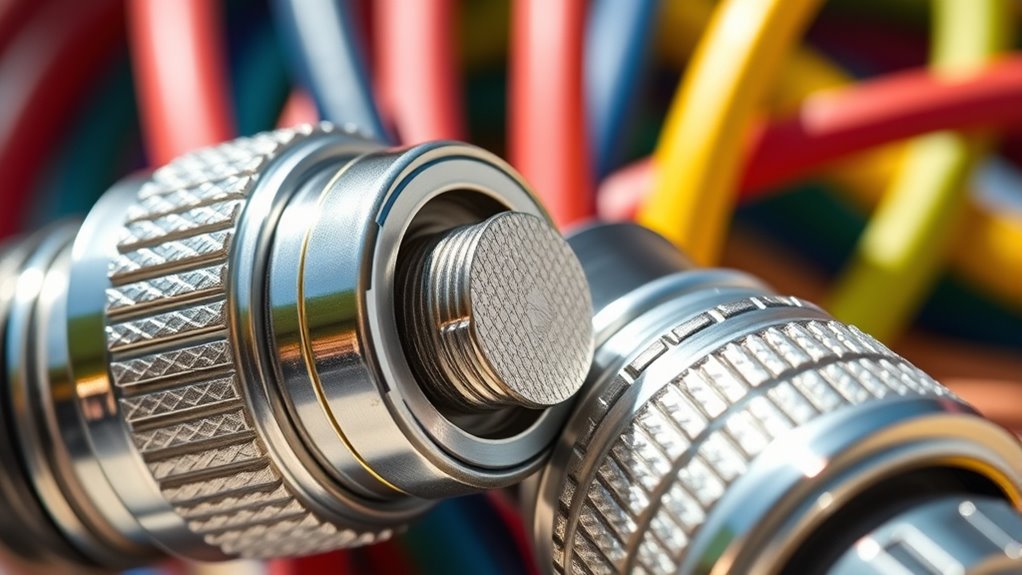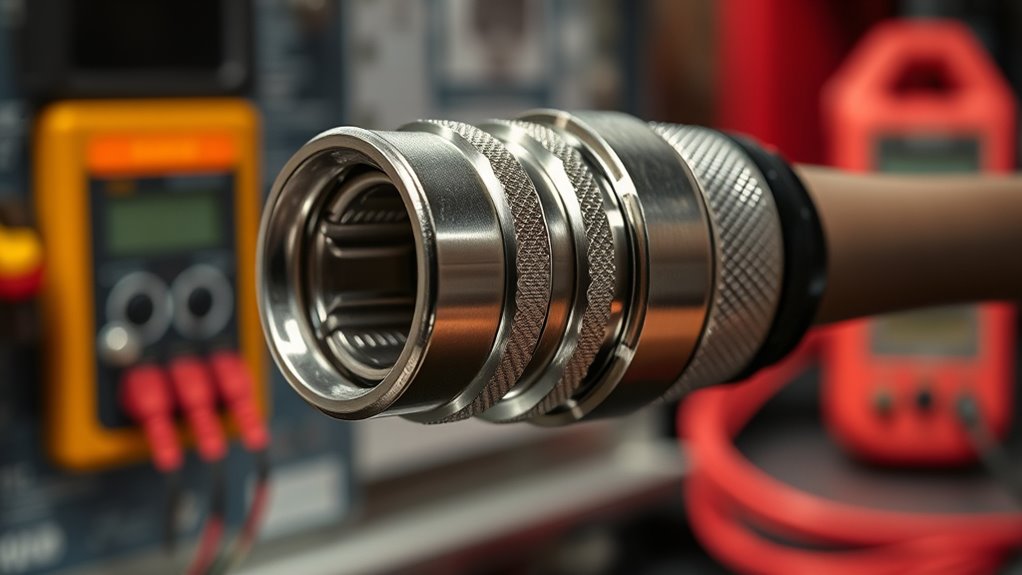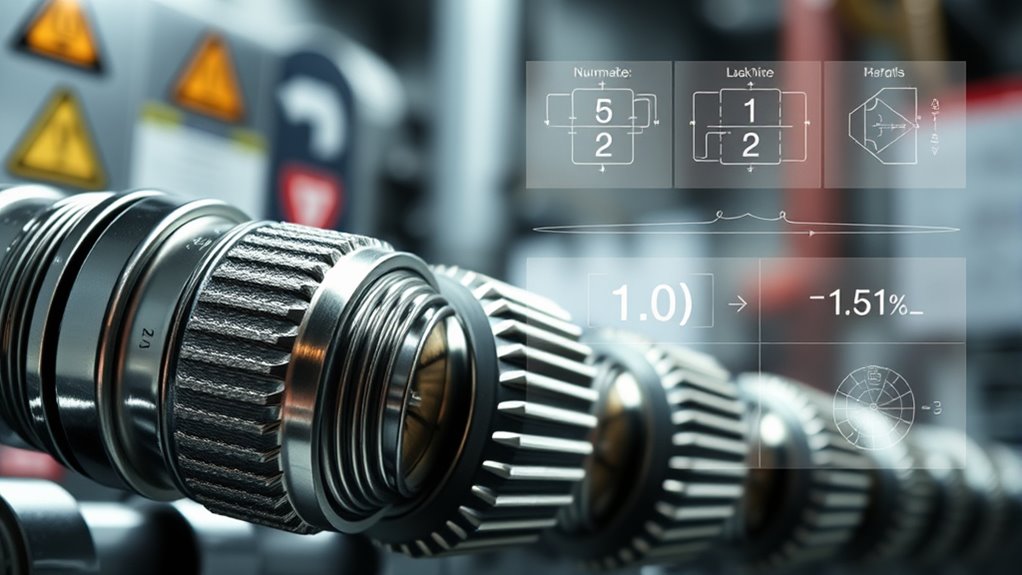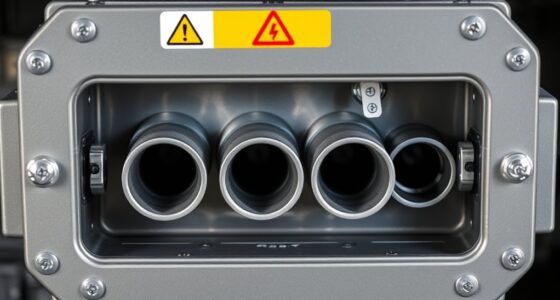To understand twist-lock connectors, you need to focus on their design, grounding features, and compatibility to guarantee a secure fit. Key calculations involve checking voltage ratings, current capacity, and voltage drop to prevent overheating or faults. Proper sizing and safety margins are vital for safety and efficiency. By considering environmental factors and industry standards, you can make accurate assessments. Keep exploring, and you’ll discover essential tips to optimize your electrical setups effectively.
Key Takeaways
- Ensure proper voltage and current ratings to prevent overheating and electrical faults.
- Calculate voltage drop across connectors to maintain safe and efficient power delivery.
- Verify connector compatibility with cable sizes and environmental conditions for reliable performance.
- Include safety margins in load calculations to account for surge and future expansion.
- Regularly inspect and maintain connectors to ensure compliance with safety standards and prevent failures.
Understanding the Basics of Twist-Lock Connectors

Have you ever wondered how twist-lock connectors guarantee a secure and reliable connection? The key lies in their design, which guarantees proper grounding requirements and connector compatibility. These connectors are built to lock securely into receptacles, preventing accidental disconnection under stress or movement. Grounding is essential for safety, so twist-lock connectors are designed with grounding contacts that meet strict electrical standards. Compatibility is also vital; you need to select the right connector type and size for your application to ensure a proper fit and reliable performance. When you understand these basics—grounding requirements and connector compatibility—you can confidently choose the right twist-lock connectors for your needs, guaranteeing both safety and efficiency in your electrical setup.
Key Electrical Parameters for Accurate Calculations

Understanding key electrical parameters is essential for accurate calculations when selecting and installing twist-lock connectors. These parameters guarantee compatibility with your cable and account for environmental factors that can impact performance. The main parameters include voltage rating, current capacity, insulation resistance, and contact resistance. Accurate knowledge of these helps prevent overheating, electrical faults, and failures. Additionally, considering vetted products ensures safety and reliability in your electrical connections. Always consider environmental factors like moisture or dust, which influence electrical performance and safety.
Determining the Right Size and Rating for Your Application

Selecting the correct size and rating for your twist-lock connectors guarantees safe and reliable connections tailored to your specific application. To do this, consider the electrical load and environment to confirm optimal connector durability. Proper sizing helps prevent overheating and mechanical failure. Review the manufacturer’s specifications and select a connector rated for your voltage and current requirements. Additionally, pay attention to installation techniques, as proper connection methods enhance both safety and longevity. Using the right size also minimizes wear and tear, extending the lifespan of your connectors. Always match the connector’s rating with your application’s needs, and follow recommended installation procedures. This approach guarantees a secure, durable connection that performs reliably over time, reducing maintenance and potential hazards. Staying informed about cryptocurrency market trends can also help anticipate future electrical infrastructure needs and ensure your connections remain compliant with evolving standards.
Calculating Voltage Drop and Power Loss

Calculating voltage drop and power loss is essential to guarantee your twist-lock connectors deliver efficient and safe performance. You need to consider grounding standards to ensure proper safety and minimize potential electrical issues. When assessing voltage drop, account for wire length, current, and conductor material, as these factors directly impact efficiency. Insulation resistance also plays a vital role; poor insulation can lead to higher power loss and safety hazards. By accurately calculating voltage drop, you prevent overloading circuits and ensure devices operate within their optimal voltage range. Power loss calculations help you identify energy inefficiencies, saving costs and extending equipment lifespan. Keep these calculations precise, adhering to grounding standards and maintaining high insulation resistance, to ensure your twist-lock connectors function reliably and safely in all applications. Regular inspections and maintenance can further prevent issues related to water exposure and ensure long-term safety and performance.
Safety Margins and Compliance Considerations

Ensuring safety margins and compliance with standards is essential when working with twist-lock connectors, as they are often used in demanding environments where electrical safety is paramount. You must adhere to installation safety guidelines and regulatory standards to prevent risks and guarantee reliable operation. To do this effectively, consider these key points:
- Always verify connectors meet local electrical codes and industry standards.
- Include safety margins in load calculations to account for unexpected surges.
- Regularly inspect connectors for wear, corrosion, or damage.
- Document compliance efforts for audits and future reference.
- Recognize that creative practice can foster innovative approaches to troubleshooting and maintenance in complex electrical systems.
Frequently Asked Questions
How Do Environmental Factors Affect Twist-Lock Connector Performance?
Environmental factors considerably influence twist-lock connector performance by affecting their durability and corrosion resistance. Harsh conditions like moisture, salt, and extreme temperatures can weaken the connector’s materials, leading to corrosion or failure. You should regularly assess and select connectors designed for specific environments to guarantee ideal environmental durability. Proper maintenance and choosing corrosion-resistant materials help maintain reliable connections, preventing costly outages or safety hazards caused by environmental damage.
Can Twist-Lock Connectors Be Used in High-Frequency Applications?
Yes, you can use twist-lock connectors in high-frequency applications, but guarantee they have appropriate material compatibility and connector durability. High-frequency signals require connectors designed to minimize signal loss and interference, so choose models specifically rated for such use. Proper material selection enhances durability and maintains performance under stress, temperature changes, or environmental exposure. Always verify that the connector’s specifications meet your application’s frequency and environmental demands for peak performance.
What Are the Common Installation Mistakes to Avoid With Twist-Lock Connectors?
Imagine installing a twist-lock connector like dressing a fancy hat on a wild, uncooperative cat—you’ll likely face installation pitfalls. To avoid this, make certain connector compatibility and don’t force fittings that don’t match. Over-tightening or rushing the process can damage components. Double-check your connections, follow manufacturer instructions, and never skip steps. Proper installation prevents future failures and keeps your setup safe and reliable—no need for a feline-sized headache.
How Do Temperature Fluctuations Impact Electrical Ratings?
Temperature fluctuations can considerably impact electrical ratings by causing thermal expansion, which may loosen connections, and insulation degradation, reducing safety and performance. When temperatures rise or fall rapidly, these effects can compromise the integrity of twist-lock connectors, leading to potential electrical faults or failures. To prevent issues, verify connectors are rated for your environment and regularly inspect them for signs of wear caused by thermal stresses.
Are There Specific Maintenance Routines to Prolong Connector Lifespan?
Did you know regular maintenance can extend your connector’s life by up to 30%? To achieve this, you should perform routine inspections, checking for signs of wear, corrosion, and loose connections. Corrosion prevention is vital; clean connectors with appropriate solutions and apply protective coatings if needed. By staying proactive, you minimize failure risks and guarantee reliable performance, saving you time and money in the long run.
Conclusion
Now that you understand the essentials of twist-lock connectors, you’re better equipped to make safe, reliable choices. Remember, it’s not just about connecting wires; it’s about connecting peace of mind with performance. By paying attention to key parameters and calculations, you guarantee your setup stands the test of time. Think of these connectors as the heartbeat of your electrical system—keep them healthy, and everything flows smoothly.









